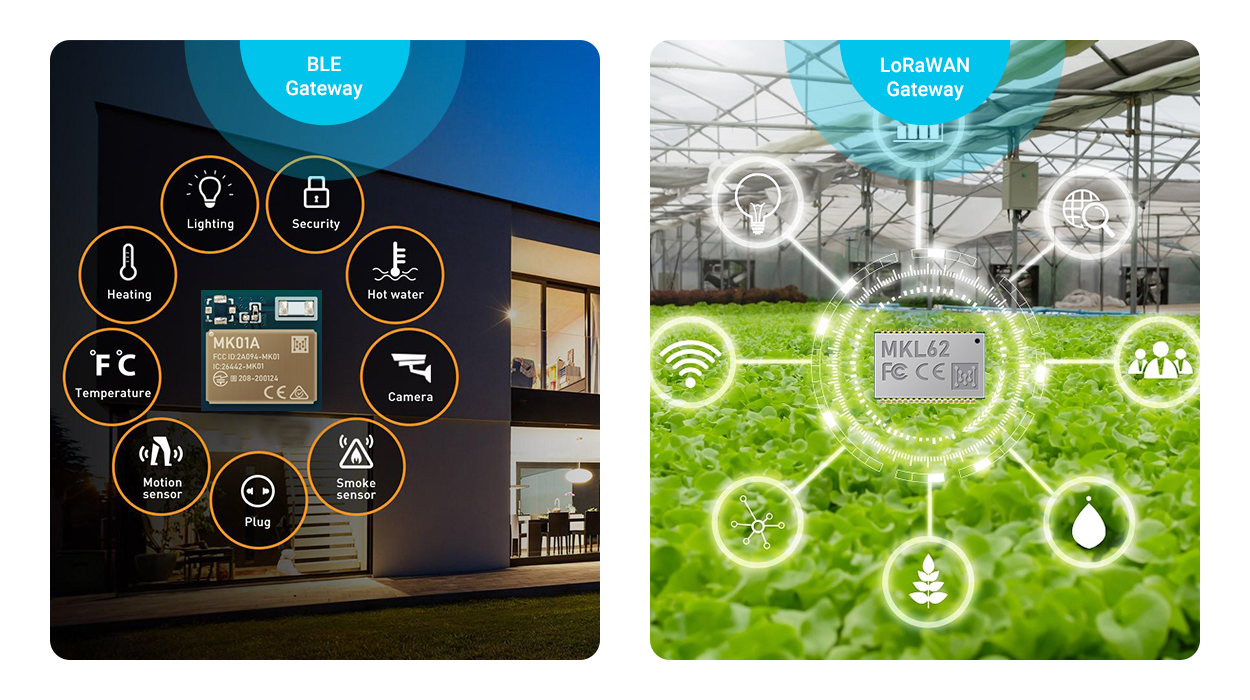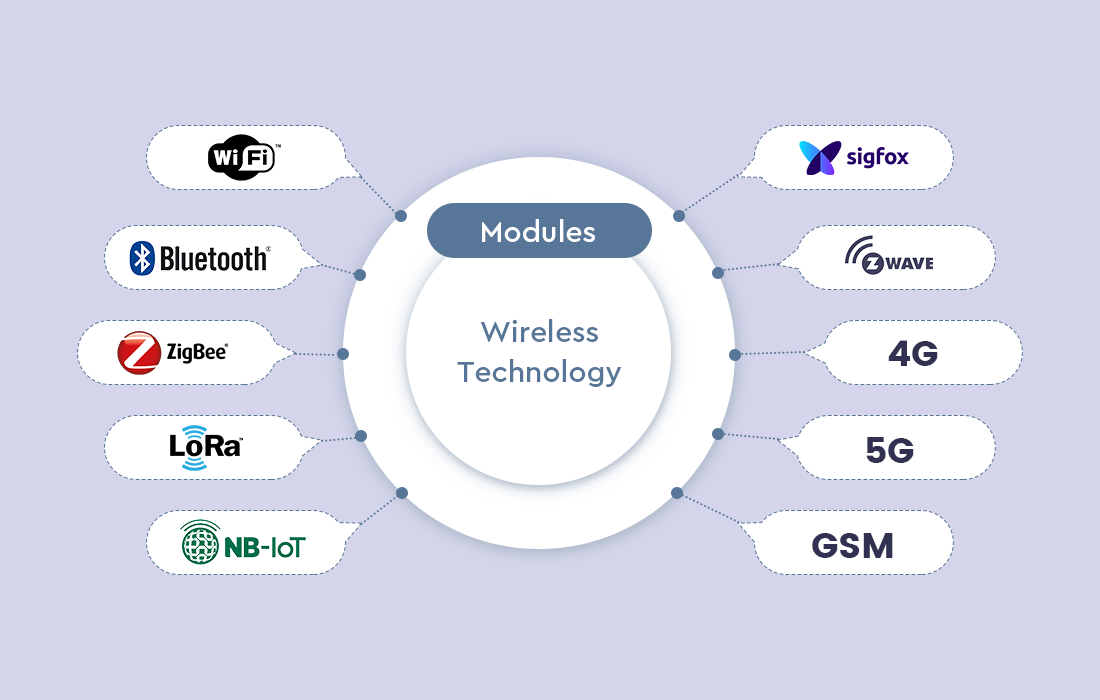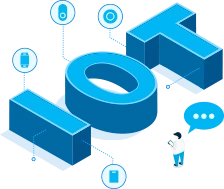Stellen Sie sich eine Welt vor, in der jedes Gerät, Von Ihrem Smart Home bis zu Ihrem Auto, ist nahtlos verbunden, Austausch von Informationen zur Verbesserung Ihres täglichen Lebens. Das ist die Essenz des Internets der Dinge, ein Bereich, in dem die Industrie floriert, Effizienz steigt, und Innovation kennt keine Grenzen. Im Herzen dieser digitalen Revolution, Wir finden intelligente Module, die eine entscheidende Rolle bei der Erleichterung der Konnektivität und Funktionalität von IoT-Geräten spielen. Sie dienen als unsichtbare Fäden, die das Gefüge des IoT verbinden, Wir befähigen Industrien, Prozesse zu optimieren, Entscheidungsfindung verbessern, und die Art und Weise, wie wir leben und arbeiten, neu definieren. In diesem Artikel, Wir beschäftigen uns mit IoT-Modulen, ihre Definition, und die verschiedenen verfügbaren Typen. zusätzlich, Wir untersuchen ihre Anwendungsfälle, und wichtige Überlegungen zur Auswahl der Arten von IoT-Modulen, und diskutieren Sie die Fortschritte bei IoT-Modulen.
Was’Es ist ein IoT-Modul?
Ein IoT-Modul ist eine kompakte elektronische Komponente, die die notwendige Hardware integriert, Firmware, und Softwarefunktionen, um drahtlose Konnektivität und Kommunikation in IoT-Geräten zu ermöglichen. Es umfasst Technologien wie Wi-Fi, Bluetooth, Zigbee, oder zellular (LTE, 5G) zum Senden und Empfangen von Daten über Netzwerke. Insgesamt, IoT-Module bilden das Konnektivitätsrückgrat für IoT-Geräte, Ermöglicht einen nahtlosen Datenaustausch und transformative Anwendungen.
8 Arten von Module mit D.unterschiedlich W.unermüdlich T.Technik
Der Bereich IoT schreitet rasant voran, Die Technologie schreitet weltweit rasant voran. Der Schlüssel zum Erfolg Ihres Projekts liegt im Verständnis der Grundprinzipien verschiedener drahtloser Kommunikationstechnologien.
W-lan mLand
Ein WiFi-Modul, auch WLAN-Modul genannt, ist eine elektronische Komponente, die in zahlreichen Produkten zum Aufbau einer drahtlosen Internetverbindung verwendet wird. Für die Entwicklung dieser WLAN-Technologie wurde der IEEE802.11-Standard verwendet. Diese Technologie wandelt kabelgebundene Netzwerksignale in Funkwellensignale um, Ermöglichen Sie anderen Geräten mithilfe drahtloser Kommunikationsmodule die drahtlose Verbindung mit dem Internet über WLAN.
Bluetooth-Modul
EIN Bluetooth-Modul ist ein grundlegender Schaltkreissatz, der einen Chip enthält, der Bluetooth-Funktionalität integriert. Es dient als drahtloses 2,4G-Kommunikationsmodul mit kurzer Reichweite. Das Bluetooth-Modul wird vom Endbenutzer als teilweise fertiges Produkt betrachtet. Durch Neuentwicklung und Kapselung der Funktion der Shell basierend auf dem Modul, Das Produkt, das Bluetooth-Kommunikation nutzen kann, ist endlich realisiert.
Zigbee-Modul
Ein Zigbee-Modul ist eine Hardwarekomponente, die die drahtlose Kommunikation zwischen Geräten ermöglichen soll, die das Zigbee-Protokoll nutzen. Zigbee ist ein drahtloses Protokoll mit geringem Stromverbrauch, das speziell für IoT-Anwendungen entwickelt wurde. Es verwendet eine Mesh-Netzwerktopologie, Dadurch können Geräte direkt miteinander oder über Zwischenknoten, sogenannte Router oder Koordinatoren, kommunizieren.
LoRa-Modul
EIN LoRa-Modul ist ein Gerät, das drahtlose Konnektivität mithilfe des LoRaWAN-Protokolls bietet. Es ist ein entscheidendes Element bei der Erstellung einer erfolgreichen LoRa-IoT-Lösung. Die weit verbreitete Einführung der LoRa-Technologie in verschiedenen Branchen treibt die steigende Nachfrage nach LoRa-Modulen voran.
NB-IoT mLand
Ein NB-IoT-Modul ist ein drahtloses Kommunikationsmodul, das speziell für IoT-Anwendungen entwickelt wurde. Es nutzt eine durch das 3rd 3GPP standardisierte LPWAN-Technologie und integriert Hardware, Firmware, und Softwarekomponenten, um IoT-Geräte mit dem Mobilfunknetz zu verbinden und Daten zu übertragen.
Sigfox-Modul
Das Sigfox-Modul ermöglicht es Geräten, sich mit dem Sigfox-Netzwerk zu verbinden und Daten zu übertragen. Es bietet Fernbedienung, Kommunikationsfunktionen mit geringem Stromverbrauch, die es IoT-Geräten ermöglichen, kleine Datenstöße über große Entfernungen zu senden und dabei nur minimale Energie zu verbrauchen.
Z-Wave-Modul
Das Z-Wave-Modul ist ein drahtloses Kommunikationsmodul, das speziell für Smart Homes entwickelt wurde. Es nutzt das Z-Wave-Funkprotokoll, das im Sub-GHz-Band arbeitet, um eine nahtlose Kommunikation zwischen intelligenten Geräten innerhalb eines Heimnetzwerks zu ermöglichen.
Mobilfunkmodule umfassen eine Reihe von Technologien, einschließlich GSM/GPRS, 5G, und 4G-Module. Diese Module sollen eine drahtlose Konnektivität über Mobilfunknetze ermöglichen.
4G-Modul
4G-Module, auch LTE-Module genannt, Bereitstellung von Hochgeschwindigkeits-Mobilfunkverbindungen für IoT-Anwendungen. Sie bieten eine zuverlässige und stabile Datenübertragung, Dadurch eignen sie sich für eine Vielzahl von IoT-Anwendungsfällen, inklusive Flottenmanagement, Gesundheitsüberwachung, und Smart Metering.
5G-Modul
5G-Module sind die nächste Generation von Mobilfunkmodulen, Speziell für 5G-Netzwerke entwickelt. 5Die G-Technologie bietet ultraschnelle Datengeschwindigkeiten, geringe Wartezeit, und umfangreiche Gerätekonnektivität, Ermöglicht fortschrittliche IoT-Anwendungen, die Echtzeitkommunikation und Funktionen mit hoher Bandbreite erfordern.
GSM/GPRS-Modul
GSM-Module nutzen Mobilfunknetze, um weltweite Konnektivität für IoT-Geräte bereitzustellen. Sie ermöglichen die Sprach- und Datenübertragung über Mobilfunknetze, Damit eignen sie sich für Anwendungen, bei denen Mobilität und eine breite Netzabdeckung unerlässlich sind.
EIN D.detailliert C.Vergleich T.fähig dazu T.Typen von ichDasT. M.Odules
| IOT MOdule | R.ANGE | T.ÜBERTRAGUNGSRATE | P.STROMVERBRAUCH | C.OST | EINANWENDUNGEN |
|---|---|---|---|---|---|
| Wi-Fi-Modul | Ortsbereich | Hoch | Mäßig | Niedrig | Mit dem Internet verbundene Geräte, Smart-Home-Automatisierung |
| Bluetooth-Modul | Kurze Reichweite | Mäßig | Niedrig | Niedrig | Persönliche Geräte, Smart-Home-Geräte |
| Zigbee-Modul | Kurze Reichweite | Niedrig | Niedrig | Niedrig | Smart-Home-Automatisierung, Industrielle Steuerungssysteme |
| LoRa-Modul | Langstrecken | Niedrig | Niedrig | Mäßig | Intelligente Städte, Landwirtschaft, Nachverfolgung von Gütern |
| NB-IoT-Modul | Große Fläche | Niedrig | Niedrig | Hoch | Intelligente Messung, Landwirtschaft, Fernüberwachung |
| Sigfox-Modul | Langstrecken | Niedrig | Niedrig | Hoch | Nachverfolgung von Gütern, Umweltüberwachung |
| Z-Wave-Modul | Kurze Reichweite | Mäßig | Niedrig | Hoch | Smart-Home-Automatisierung |
| 4G-Modul | Große Fläche | Hoch | Mäßig bis hoch | Mäßig | Videoüberwachung, Telematik, Industrielle Automatisierung |
| 5G-Modul | Große Fläche | Sehr hoch | Mäßig bis hoch | Hoch | Erweiterte Realität, autonome Fahrzeuge, Intelligente Städte |
| GSM-Modul | Global | Mäßig bis hoch | Mäßig | Hoch | Ortungsgeräte, Fernüberwachungssysteme |
Vergleichen sNahbereichs-IoT Module: Bluetooth und notwendige behördliche Auflagen W.ich-F.ich und notwendige behördliche Auflagen Zigbee und notwendige behördliche Auflagen Z-Wave
Auswahl an IoT-Modulen
WLAN-Module haben die größte Reichweite, Bietet eine Reichweite von mehreren hundert Fuß bis mehreren hundert Metern, eine größere Distanz zurücklegen als ZigBee, Z-Wave, und Bluetooth-Module. ZigBee und Z-Wave sind für die Heimautomation konzipiert und haben eine Reichweite von bis zu 30 Meter, wohingegen Bluetooth eine Reichweite von bis zu hat 10 Meter, aber neuere Versionen wie Bluetooth 5.0 kann erweiterte Reichweiten von bis zu bieten 100 Meter.
Datenübertragungsrate von IoT-Modulen
Das Bluetooth 5.0 Das Transportprotokoll liegt in Bereichen wie Smart Homes und tragbaren Geräten immer noch vor WiFi-Modulen, WiFi-Module verfügen aber auch über sehr schnelle drahtlose Übertragungsgeschwindigkeiten und eine große Abdeckung. Das WLAN-Modul erreicht eine Spitzengeschwindigkeit von mehreren Gigabit pro Sekunde, Dies macht es ideal für die Übertragung großer Datenmengen. ZigBee und Z-Wave sind für Anwendungen mit geringem Datenvolumen konzipiert und weisen im Vergleich zu Wi-Fi geringere Datenübertragungsraten auf.
Stromverbrauch von IoT-Modulen
Sowohl ZigBee als auch Z-Wave sind darauf ausgelegt, einen niedrigen Stromverbrauch zu priorisieren, Dadurch eignen sie sich gut für batteriebetriebene Geräte wie intelligente Sensoren und intelligente Thermostate. Das Bluetooth-Modul verfügt außerdem über einen Energiesparmodus, Im hohen Datenübertragungsmodus verbraucht es jedoch mehr Strom. WLAN-Module benötigen aufgrund ihrer höheren Datenübertragungsraten mehr Strom als diese Technologien.
Der Preis von IoT-Module
Unter diesen vier Modulen, Am günstigsten sind Bluetooth-Module, während Z-Wave-Module am teuersten sind. Wi-Fi- und Zigbee-Module liegen dazwischen, wobei WLAN etwas günstiger ist als Zigbee-Module.
Anwendung von IoT-Module
Bluetooth wird häufig für Kommunikationszwecke im Nahbereich eingesetzt, Erleichterung der drahtlosen Konnektivität zwischen Geräten wie Smartphones und Tablets. Wi-Fi wird zur Übertragung von Daten mit hoher Geschwindigkeit genutzt und wird häufig in Wohn- und Büroumgebungen für Netzwerkzwecke und IoT-Anwendungen eingesetzt. ZigBee und Z-Wave, andererseits, wurden speziell für die Hausautomation entwickelt, Suche nach Anwendungen in Geräten wie der Lichtsteuerung, und drahtlose Sensornetzwerke.
Vergleichen Sie Langstrecken IoT Module: LoRa gegen Sigfox und notwendige behördliche Auflagen NB-IoT und notwendige behördliche Auflagen 4G und notwendige behördliche Auflagen 5G vs. GSM
Auswahl an IoT-Modulen
Allgemein, Sigfox-Module sind so konzipiert, dass sie eine globale Abdeckung bieten, indem sie mit lokalen Betreibern zusammenarbeiten und deren Netzwerkinfrastruktur bereitstellen. LoRa-Module verfügen im Allgemeinen über eine Reihe von 5-15 km. Abhängig von der Netzwerkinfrastruktur, 4G-Module bieten eine Reichweite von wenigen Kilometern bis zu mehreren zehn Kilometern. Die Verbindungsreichweite zwischen 5G-Modulen und NB-IoT-Modulen ist relativ gering, normalerweise von einigen hundert Metern bis zu einigen Kilometern.
Datenübertragungsrate von IoT-Modulen
5Das G-Modul unterstützt sehr hohe Datenraten (bis zu mehreren Gbit/s), Damit eignet es sich ideal für geschäftskritische IoT-Anwendungen und solche, die eine Echtzeit-Datenverarbeitung erfordern. Das LoRa-Modul unterstützt Datenraten bis zu 50 kbit/s und eignet sich für Anwendungen mit geringen bis mittleren Datenübertragungsanforderungen. NB-IoT-Module unterstützen auch niedrige bis mittlere Datenraten, typischerweise im Bereich von mehreren zehn Kbit/s bis zu einigen hundert Kbit/s. Sigfox hat niedrigere Datenraten (bis zu 100 bps) und eignet sich am besten für Anwendungen, die eine minimale Datenübertragung erfordern. Das 4G-Modul bietet im Vergleich zu LoRa höhere Datenraten, NB-IoT, und Sigfox. Sie können alles von wenigen Mbit/s bis zu mehreren zehn Mbit/s unterstützen.
Stromverbrauch von IoT-Modulen
Das 5G-Modul ist im Vergleich zu den anderen vier das stromhungrigste, Dies liegt vor allem an den höheren Datenraten und der fortschrittlichen Technologie. Das 4G-Modul verbraucht aufgrund höherer Datenraten und komplexerer Netzwerkprotokolle typischerweise mehr Strom als die übrigen drei Module. LoRa, NB-IoT, und Sigfox sind speziell für den Betrieb mit geringem Stromverbrauch konzipiert, Dadurch eignen sie sich hervorragend für batteriebetriebene Geräte, die mehrere Jahre halten müssen.
Kosten für IoT-Module
LoRa-Module sind aufgrund ihrer geringeren Komplexität im Allgemeinen kostengünstiger als 4G- und 5G-Module und konzentrieren sich auf Fernkommunikation mit niedrigen Datenraten. Die Kosten für Sigfox- und NB-IoT-Module können variieren, Aufgrund ihres Fokus auf Einfachheit und geringem Stromverbrauch sind sie jedoch in der Regel relativ erschwinglich. 4G-Module umfassen in der Regel fortschrittlichere Technologie und Infrastruktur, was zu höheren Kosten im Vergleich zu LoRa- und Sigfox-Modulen führen kann. Das 5G-Modul repräsentiert die neueste Generation der Mobilfunktechnologie, bietet superschnelle Geschwindigkeiten, geringe Wartezeit, und eine große Anzahl an Geräteanschlüssen, Dies führt dazu, dass die Herstellung teurer ist als bei anderen Optionen.
Anwendung von IoT-Modulen
LoRa-Module eignen sich hervorragend für Szenarien, die eine Kommunikation über große Entfernungen und einen geringen Stromverbrauch erfordern, Damit sind sie ideal für Anwendungen wie Smart-City-Lösungen. Sigfox-Module, andererseits, eignen sich gut für Anwendungen, bei denen niedrige Datenraten im Vordergrund stehen, verlängerte Akkulaufzeit, und weltweite Netzabdeckung, Dies macht sie zu einer beliebten Wahl für Anwendungen wie die Umweltüberwachung. Das NB-IoT-Modul ermöglicht Remote-Konnektivität, Damit eignet es sich gut für Anwendungen wie Fernüberwachung, die eine effiziente und nachhaltige Kommunikation erfordern. 4G-Module werden häufig für Hochgeschwindigkeits-Internetverbindungen eingesetzt, Mobile Kommunikation, und Anwendungen, bei denen große Datenmengen übertragen werden müssen. 5G-Module zielen hauptsächlich auf Anwendungen ab, die eine ultraschnelle Geschwindigkeit erfordern, geringe Wartezeit, und umfangreiche Gerätekonnektivität, wie autonome Fahrzeuge. GSM-Module ermöglichen die Kommunikation über das GSM-Netz, Sie werden häufig in Telematik- und Sicherheitssystemen eingesetzt.
Bluetooth vs. W-lan und notwendige behördliche Auflagen. LoraVAN und notwendige behördliche Auflagen. ZigBee vs. GSM und notwendige behördliche Auflagen. NB-IoT und notwendige behördliche Auflagen. Z-Welle vs. Sigfox vs. 5G vs. 4G: Welches IoT-Modul ist besser?
Bestimmen der “besser” Das IoT-Modul hängt von den spezifischen Anforderungen Ihrer IoT-Anwendung ab. Jedes Modul hat seine eigenen Vorteile und Eigenschaften, die es für verschiedene Anwendungsfälle geeignet machen. Nachfolgend listen wir einige Vorteile verschiedener IoT-Modultypen auf:
Bluetooth Module
- Energieeffizient
- Einfache Kopplung und Konnektivität
WiFi Module
- Hohe Datenübertragungsraten
- Kompatibilität mit bestehender Infrastruktur
LoraVAN Module
- Geringer Stromverbrauch für längere Batterielebensdauer
- Hervorragende Durchdringung von Hindernissen
ZigBee Module
- Mesh-Netzwerkunterstützung für erweiterte Abdeckung
- Skalierbarkeit für große Netzwerke
GSM Module
- Weltweite Abdeckung in den meisten Regionen
- Etablierte Infrastruktur für zuverlässige Kommunikation
NB-IoT Module
- Unterstützung für umfangreiche IoT-Bereitstellungen
- Kostengünstige Konnektivität
Z-Welle Module
- Energieeffizient
- Interoperabilität mit einer Vielzahl von Geräten
Sigfox Module
- Energieeffizient
- Kostengünstige Konnektivität
- Optimiert für einfache und kleine Datenübertragungen.
4G Module
- Hochgeschwindigkeits-Datenübertragungsraten.
- Breite Netzabdeckung
5G Module
- Ultraschnelle Datenübertragungsraten.
- Geringe Latenz für Echtzeitanwendungen
Berücksichtigen Sie die Vorteile dieser Module sowie Ihre spezifischen Anforderungen, um zu bestimmen, welches IoT-Modul für Ihre Anwendung besser geeignet ist. Es ist auch erwähnenswert, dass Hybridlösungen, die mehrere Module kombinieren, in manchen Szenarien von Vorteil sein können, um die Vorteile verschiedener Technologien zu nutzen.
Anwendungs Arten von IoT M.Odules
Aus der aktuellen Entwicklungslage, Die typischen Anwendungen von Modultypen im Bereich IoT sind wie folgt:
Smart-Home-Automatisierung: IoT-Module werden verwendet, um Smart Homes zu schaffen, in denen Geräte wie Lichter integriert sind, Thermostate, Sicherheitssysteme, und Geräte können aus der Ferne gesteuert und automatisiert werden.
Industrielle Automatisierung: IoT-Module ermöglichen die Automatisierung und Überwachung industrieller Prozesse, Optimierung der Effizienz und Reduzierung menschlicher Eingriffe. Sie werden beispielsweise in der Fertigung eingesetzt, Leitung der Lieferkette, und vorausschauende Wartung.
Umweltüberwachung: IoT-Module werden zur Überwachung von Umweltfaktoren wie der Luftqualität eingesetzt, Temperatur, Feuchtigkeit, und Verschmutzungsgrad. Sie helfen bei der Verfolgung und Analyse von Daten für ein besseres Umweltmanagement.
Gesundheitswesen und Wearables: IoT-Module werden in Gesundheitsanwendungen wie der Fernüberwachung von Patienten eingesetzt, tragbare Gesundheits-Tracker, und intelligente medizinische Geräte. Sie sammeln wichtige Gesundheitsdaten und ermöglichen eine Überwachung und Analyse in Echtzeit.
Intelligente Landwirtschaft: IoT-Module ermöglichen eine Präzisionslandwirtschaft durch Überwachung der Bodenfeuchtigkeit, Wetterverhältnisse, Pflanzengesundheit, und Vieh. Diese Daten helfen, die Bewässerung zu optimieren, Düngung, und Tierhaltungspraktiken.
Intelligente Städte: IoT-Module werden zum Aufbau von Smart-City-Infrastrukturen für ein effizientes Verkehrsmanagement eingesetzt, Abfallwirtschaft, Parksysteme, Energieüberwachung, und öffentliche Sicherheit.
Asset-Tracking und Logistik: IoT-Module werden eingesetzt, um Vermögenswerte und Sendungen in Echtzeit zu verfolgen und zu verwalten, Optimierung der Logistikabläufe, Reduzierung von Verlusten, und Verbesserung der Transparenz der Lieferkette.
Energiemanagement: IoT-Module helfen bei der Überwachung und Steuerung des Energieverbrauchs in Wohngebäuden, kommerziell, und Industrieumgebungen. Sie ermöglichen Smart Metering, erwarte Antwort, und effiziente Energienutzung.
Smart Retail: IoT-Module erleichtern die Bestandsverwaltung, Regalüberwachung, und personalisierte Kundenerlebnisse in Einzelhandelsumgebungen. Sie verbessern das gesamte Einkaufserlebnis und ermöglichen gezielte Marketingkampagnen.
Flottenmanagement: IoT-Module werden in Fahrzeugverfolgungs- und Flottenmanagementsystemen zur Überwachung des Fahrzeugstandorts eingesetzt, Performance, und Wartungsbedarf. Sie verbessern die betriebliche Effizienz und Sicherheit.

Fortschritte im IoT Modul Technologie Die Ergebnisse besagen, dass die nächste industrielle Revolution dazu führen wird, dass die Mehrheit der verschiedenen Industriezweige innerhalb der nächsten fünf Jahre primäre Robotik-Administratoren beschäftigen wird
Es wird erwartet, dass das System auf dem Modulmarkt einen Wert von US-Dollar erreicht 1.15 Milliarden in 2023 und wird voraussichtlich auf wachsen US$ 4.65 Milliarden von 2033. Der Markt wird voraussichtlich eine CAGR von aufweisen 15% im Prognosezeitraum.
In der Vergangenheit, Die IoT-Modultechnologie hat in Bereichen wie der Miniaturisierung Fortschritte gemacht, Energie-Effizienz, Konnektivitätsoptionen, Datenverarbeitung und -speicherung, und Sicherheit. Diese Fortschritte haben IoT-Module kleiner gemacht, energieeffizienter, und in der Lage, vielfältige drahtlose Konnektivität zu ermöglichen. zusätzlich, Verbesserungen bei der Datenverarbeitung und den Sicherheitsfunktionen haben die Funktionalität und Zuverlässigkeit von IoT-Lösungen verbessert.
Vorausschauen, Es wird erwartet, dass sich die IoT-Modultechnologie weiterentwickeln wird. Zu den erwarteten Fortschritten gehören Edge-Computing-Funktionen, Nutzung der 5G-Konnektivität für schnellere und zuverlässigere Verbindungen, Integration von KI für die Verarbeitung und Entscheidungsfindung auf dem Gerät, Verbesserte Sensorfunktionen für eine präzisere Datenerfassung, Blockchain-Integration für verbesserte Sicherheit und Datenintegrität, und Bemühungen um Standardisierung und Interoperabilität. Diese zukünftigen Fortschritte werden das Wachstum und die Einführung von IoT-Lösungen vorantreiben, Ermöglichung innovativer Anwendungen in allen Branchen und Förderung eines vernetzteren und effizienteren IoT-Ökosystems.
Anders Arten von IoT-Modulen von MOKOSmart
Vergessen Sie nie, dass Ihre IoT-Bereitstellung auch von den Netzwerkdiensten Ihres Netzbetreibers abhängt, Wählen Sie also einen vertrauenswürdigen Anbieter. MOKOSmart ist ein Unternehmen, das sich seit mehr als siebzehn Jahren mit Modultypen beschäftigt. Es hat sich der Entwicklung der neuesten Technologie im Einklang mit der wissenschaftlichen und sozialen Entwicklung verschrieben, was bei vielen Kunden gut ankommt. Im Folgenden sind einige beliebte Modultypen von MOKOSmart aufgeführt, die sich gut verkaufen:
Bluetooth-Modul: MOKOSmart ist ein professioneller Hersteller von BLE-Modulen. Unser Modulportfolio ist auf robuste Leistung ausgelegt, einfache globale Zertifizierung, und einfache Umsetzung. Bluetooth 5.2 erweitert nicht nur die Reichweite der Kommunikation, Ermöglicht Geräten die Kommunikation über größere Entfernungen, integriert aber auch Energiesparfunktionen, die einen effizienten Betrieb der Geräte bei gleichzeitiger Minimierung des Energieverbrauchs ermöglichen. Der Frequenzbereich von 2360 MHz bis 2500 MHz bietet ein relativ störungsfreies Spektrum für die Bluetooth-Kommunikation. AES-128 gewährleistet eine sichere Kommunikation durch die Verschlüsselung der zwischen Geräten übertragenen Daten. Aufgrund dieser Eigenschaften eignen sie sich hervorragend für ein breites Anwendungsspektrum, einschließlich IoT-Geräten, Tragfähig, Audiogeräte, Smart-Home-Automatisierungssysteme, Gesundheitsgeräte, und zahlreiche andere Domänen.
LoRa-Modul: MOKOSmart gilt als einer der führenden Hersteller von LoRa-Modulen, Bereitstellung einer nahtlosen Integration in verschiedenen wichtigen Bereichen des IoT. Unsere LoRa-Module bieten eine Reihe von Funktionen, die sie für IoT-Anwendungen äußerst wünschenswert machen. Aufgrund ihrer geringen Größe und einfachen Entwicklung und Integration, Sie bieten Flexibilität und Komfort. zusätzlich, LoRa-Module verfügen über eine Kommunikationsentfernung von bis zu 10 km, Dadurch eignen sie sich für Konnektivität über große Entfernungen. Sie zeichnen sich durch Energieeffizienz aus, verbrauchen minimale Energie, und weisen eine hohe Empfangsempfindlichkeit auf, Ermöglicht einen zuverlässigen Datenempfang auch in anspruchsvollen Umgebungen. Außerdem, LoRa-Module bieten eine hohe Tx-Leistung von bis zu 21 dBm, Gewährleistung einer robusten Signalübertragung für eine erweiterte Abdeckung.
Fazit
In einem Wort, Die Auswahl eines zuverlässigen IoT-Funkmoduls ist für den Erfolg von IoT-Projekten von entscheidender Bedeutung. Die Modultypen von MOKOSmart bieten eine robuste Leistung, nahtlose Konnektivität, und umfassende Kompatibilität, Dies macht uns zu einer vertrauenswürdigen Wahl für verschiedene IoT-Anwendungen. Durch das Verständnis drahtloser Technologien, Beurteilung der Bewerbungsvoraussetzungen, und Berücksichtigung von Schlüsselfaktoren, Unternehmen können fundierte Entscheidungen treffen und den reibungslosen Betrieb ihrer IoT-Implementierungen sicherstellen. Die Auswahl eines zuverlässigen IoT-Moduls ebnet den Weg zur Erschließung des vollen Potenzials des Internets der Dinge und treibt Innovationen branchenübergreifend voran.
Lesen Sie weiter über die IoT-MODULE
























